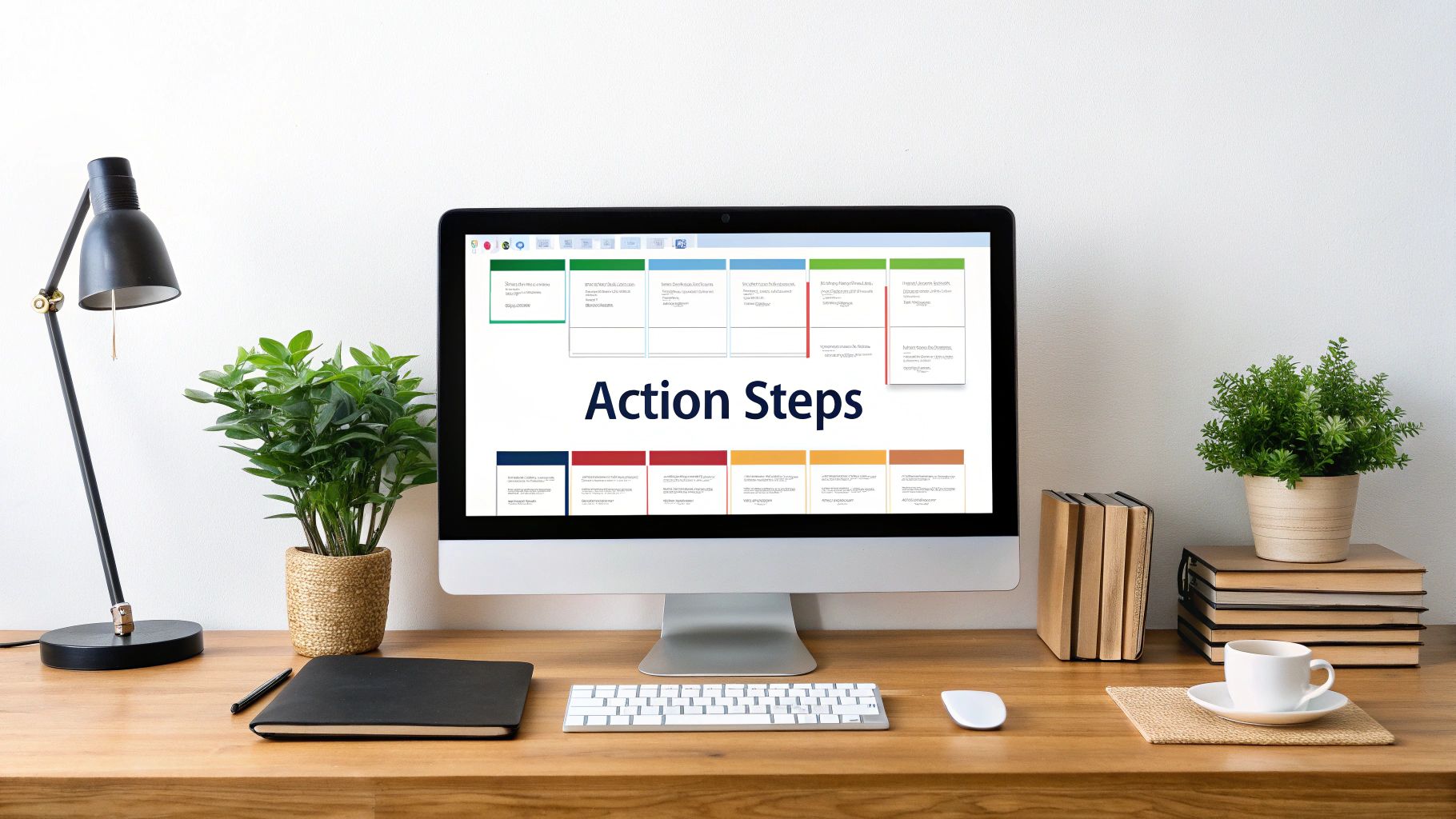
Business Goal Setting Template | Boost Your Growth
Share
The Science Behind Structured Goal Setting

Structured goal setting is more than just a popular business practice. It’s a fundamental shift in how organizations approach success. Using business goal setting templates provides a framework for clarity and alignment, turning abstract ideas into concrete action plans. This enhanced focus drives significant business outcomes.
One key advantage of using templates is the reduction in decision fatigue for leaders. Instead of constantly creating new processes, leaders can use established frameworks to guide their teams. This frees up valuable time and mental energy for strategic problem-solving and innovation. Templates also foster a shared understanding of expectations across teams.
This collaborative environment is further strengthened by establishing a common language for measuring progress. This eliminates ambiguity and ensures everyone works towards the same objectives. A well-defined business goal setting template can bridge communication gaps between, for instance, marketing and sales teams, aligning their efforts toward a common customer acquisition target. This cohesive approach minimizes miscommunication and maximizes efficiency.
Furthermore, using structured templates helps organizations avoid common goal-setting pitfalls. Vague objectives, unrealistic timelines, and misaligned priorities can hinder even the most promising strategic initiatives. Templates mitigate these risks by providing a structured approach to defining goals, outlining timelines, and allocating resources effectively.
The Impact of the SMART Framework
The SMART goal-setting framework, introduced by George Doran in 1981, has been widely adopted. A 2020 meta-analysis showed organizations using structured templates like SMART achieve 70-80% higher goal completion rates compared to informal approaches. For example, Google's OKR (Objectives and Key Results) system, derived from structured goal templates, helped scale Alphabet Inc. to $182.5 billion in revenue in 2020 by cascading goals across its 150,000+ employees.
Templates incorporating the SMART criteria (Specific, Measurable, Achievable, Relevant, Time-bound) now underpin 60% of Fortune 500 goal-setting processes, according to AchieveIt's 2023 industry report.
By embedding best practices and prompting critical thinking, templates empower teams to set ambitious yet attainable goals. This translates into a higher likelihood of achieving desired outcomes. This structured, data-driven approach empowers businesses to make informed decisions, track progress meticulously, and adapt strategies as needed, ultimately contributing to significant improvements in overall performance. You might also be interested in our blog sitemap for more helpful articles.
Essential Components of High-Impact Goal Templates

Building a successful business requires a clear vision and a well-defined path to reach it. Effective business goal setting templates provide this crucial structure, transforming aspirations into actionable steps. This section examines the essential components that make these templates effective for real-world business applications.
Defining Clear Objectives
The cornerstone of any successful goal template is a set of clearly defined objectives. This means articulating precisely what needs to be accomplished. Instead of a vague goal like "improve customer satisfaction," a specific objective might be "increase customer satisfaction survey scores by 15% within six months." This clarity ensures that everyone understands the target and can work together effectively.
This clarity also ensures there's no room for misinterpretation. Everyone involved understands exactly what the target is, how it's measured, and what constitutes success. This shared understanding is essential for coordinating efforts and driving progress.
Establishing Meaningful KPIs
Once objectives are defined, the next step is establishing Key Performance Indicators (KPIs). These are the quantifiable metrics that will be used to track progress toward each objective. A suitable KPI for the customer satisfaction objective might be "average customer satisfaction score." Choosing the right KPIs is crucial for monitoring performance and making data-driven decisions.
These metrics enable businesses to monitor performance effectively. By regularly tracking KPIs, companies can identify trends, spot potential problems, and make informed adjustments to their strategies. This data-driven approach is essential for maximizing the chances of achieving objectives.
Setting Realistic Timelines
Effective goal templates include realistic timelines. This involves breaking down larger goals into smaller, manageable milestones, each with a specific deadline. For instance, a yearly goal could be broken down into quarterly, monthly, or even weekly targets. This approach creates a sense of urgency and promotes consistent progress.
Breaking down larger objectives into smaller steps makes them less daunting and more achievable. It also allows for more frequent progress checks, ensuring the team stays on track and can address any roadblocks promptly.
Assigning Unambiguous Responsibilities
Clarity of ownership is paramount for successful goal achievement. Templates should clearly state who is responsible for each objective and its related tasks. This eliminates confusion and fosters accountability. This defined ownership empowers individuals and creates a sense of responsibility for their contributions.
Furthermore, clear roles help to streamline communication. Everyone knows who to contact for updates, questions, or assistance. This streamlined communication is vital for maintaining momentum and ensuring a smooth workflow. Learn more in our article about How to master....
Resource Allocation and Planning
High-impact goal templates consider resource requirements. This means identifying and allocating the necessary resources, whether financial, personnel, or technological. For example, a goal to launch a new product line might require funding for research and development, marketing, and sales. Proactive resource planning sets teams up for success by ensuring they have what they need to execute the plan.
Without proper resource allocation, even the most well-defined objectives can flounder. A comprehensive goal template addresses these needs upfront, reducing the risk of delays and ensuring the team has the necessary tools and support to achieve their targets.
Incorporating Progress Milestones and Review Mechanisms
Regular progress reviews are essential for maintaining momentum and making necessary adjustments. Effective templates incorporate milestones and scheduled review points to evaluate performance and adapt strategies as needed. This allows for timely course correction and helps keep the project aligned with the overall objective.
These reviews could involve weekly check-ins, monthly progress reports, or quarterly performance evaluations. The frequency and format of these reviews should be tailored to the specific goals and the overall project timeline.
Adaptability and Flexibility
While structure is crucial, effective templates must also be adaptable. Business environments are dynamic, and goals often need to be adjusted based on changing circumstances or new opportunities. A good template allows for adjustments without sacrificing overall alignment. This flexibility ensures that the goal-setting process remains a valuable tool for navigating an evolving business landscape.
This adaptability is key to ensuring the goal-setting process remains a valuable tool, not a rigid constraint.
To summarize the key elements for creating impactful goals, consider the following table:
Must-Have Elements in Effective Goal Templates
A comprehensive breakdown of essential components every business goal setting template should include, with practical examples for immediate implementation
| Component | Purpose | Example | Implementation Tips |
|---|---|---|---|
| Clear Objectives | Define precisely what needs to be accomplished | Increase customer satisfaction survey scores by 15% within six months | Use specific, measurable, achievable, relevant, and time-bound (SMART) criteria |
| Meaningful KPIs | Quantifiable metrics to track progress | Average customer satisfaction score | Choose KPIs directly related to the objectives |
| Realistic Timelines | Breakdown goals into smaller milestones with deadlines | Yearly goal broken down into quarterly targets | Set achievable deadlines and create a sense of urgency |
| Unambiguous Responsibilities | Define ownership for each objective and tasks | Assign specific individuals to lead each aspect of the goal | Ensure everyone knows their role and who to contact for support |
| Resource Allocation | Identify and allocate necessary resources | Allocate budget for market research and marketing campaigns | Plan resource needs proactively |
| Progress Milestones & Reviews | Regular assessments to track progress and adapt | Weekly check-ins and monthly reports | Schedule regular reviews and adjust strategies as needed |
| Adaptability & Flexibility | Allow for modifications based on changing circumstances | Adjust timelines or resource allocation based on market changes | Build flexibility into the template to accommodate unforeseen events |
This table outlines the fundamental building blocks for crafting goal templates that drive results. By incorporating these elements, businesses can transform their aspirations into tangible achievements.
Transforming SMART Principles Into Actionable Templates

The SMART framework (Specific, Measurable, Achievable, Relevant, Time-bound) provides a strong foundation for effective goal setting. But truly effective goals require more than just a framework. They require action. That's where business goal setting templates come in. These templates serve as practical roadmaps, guiding users toward well-defined objectives and measurable results. This section explores how to structure template fields to maximize the impact of SMART principles.
Structuring Templates For SMART Goals
A well-structured template seamlessly guides users through the SMART criteria. For Specificity, include fields prompting users to answer the who, what, where, when, why, and how of their goal. This detail eliminates ambiguity and ensures everyone is aligned. For example, instead of "increase sales," a template might ask users to specify the product line, target market, and sales channels.
Measurability is crucial for tracking progress. Templates address this by incorporating fields for key metrics and target values. This allows for objective evaluation and quantifiable results. Fields for "Starting Value," "Target Value," and "Measurement Frequency" prompt users to define their tracking process precisely.
Templates also address Achievability by incorporating questions that encourage users to assess available resources and potential obstacles. This realistic approach helps ensure goals are challenging yet attainable. Prompting users to reflect on past performance and current limitations helps them set realistic targets.
Relevance connects individual goals to the bigger picture. Templates can include a section linking goals to broader departmental or organizational strategies, ensuring all efforts contribute to the overall mission.
Finally, Time-bound goals are essential for maintaining momentum. Templates facilitate this with fields requiring specific deadlines and milestones. Including fields for "Start Date," "End Date," and key milestones creates a sense of urgency and keeps everyone on track.
A 2022 PwC survey revealed that 83% of executives in North America and Europe use standardized goal-setting templates, with companies reporting a 30-40% improvement in cross-departmental alignment. Microsoft's "Connected Workplace" template, for instance, reduced silos during its 2017 reorganization and contributed to a $143 billion revenue increase by 2022. Globally, SaaS platforms like Smartsheet and Cascade.app report over 5 million active users leveraging goal-tracking templates as of 2024. These templates emphasize metrics like quarterly KPIs (e.g., 20% YoY revenue growth targets) and 90-day sprint cycles. More detailed statistics can be found here.
Prompting Deeper Thinking Through Template Design
Business goal setting templates can be designed to encourage more in-depth thinking and greater specificity. Targeted questions can help users clarify their objectives and anticipate potential challenges. For instance, asking "What specific actions will contribute to achieving this goal?" prompts users to consider the necessary steps and resources.
Templates can also include examples of well-defined SMART goals across different business functions. This provides users with practical models and promotes best practices. A practical application of the SMART framework across different departments like sales, marketing, operations, and finance ensures a structured approach benefits all aspects of the business. Check out our guide on How to master.... By tailoring templates to each department's needs and priorities, goals remain relevant and impactful. This detailed guidance helps ground ambitious goals in reality, increasing the likelihood of success and fostering overall business growth.
Digital Platforms That Supercharge Your Business Goal Setting Templates

Digital tools have significantly changed how businesses manage their goals. These platforms offer customizable business goal setting templates, impacting how we plan, track, and achieve objectives. This section examines leading platforms, including dedicated goal management software and integrated project management solutions, that can improve your goal-setting process.
Key Features for Maximum ROI
Digital platforms offer a range of features that boost goal management and offer a substantial return on investment. Real-time progress visualization provides immediate feedback, enabling prompt adjustments. This transparency promotes accountability and keeps teams engaged.
Automated notifications simplify communication and ensure everyone stays informed about deadlines, updates, and accomplishments.
Integrating with your existing tech stack is vital for a smooth workflow. For example, syncing your goal-setting platform with your project management or CRM system centralizes information and streamlines data analysis. This minimizes manual data entry and improves accuracy.
Supporting Diverse Goal Methodologies
Different digital tools support various goal methodologies to suit diverse planning approaches. Whether your company uses OKRs, KPIs, or the SMART framework, picking a platform that aligns with your methods is critical for success.
Some platforms are specifically designed for visualizing OKRs, while others excel at tracking individual KPIs. Understanding these distinct features will help you choose the right tool for your business. The ideal platform supports your chosen framework, providing the structure and features needed for its success.
Choosing the Right Platform for Your Business
The right digital platform depends on your specific business needs. Consider factors like company size, complexity, and workflow when deciding. A small startup may find value in a simple, user-friendly platform, while a larger enterprise may require a more powerful solution with advanced capabilities and integrations.
A project-based company might prioritize integrating with project management tools, while a sales-focused company might value CRM integration. Factoring in these needs ensures a seamless transition and promotes adoption across the company.
To help you navigate your choices, we've compiled a comparison of leading platforms:
Introducing the following table which provides a detailed comparison of leading software solutions offering robust goal setting templates and tracking capabilities for businesses of all sizes.
| Platform | Best For | Key Features | Pricing Model | Integration Capabilities |
|---|---|---|---|---|
| Monday.com | Teams and departments | Customizable templates, progress tracking, collaboration tools | Subscription-based | Wide range of integrations including project management and CRM tools |
| Asana | Project management | Goal setting within projects, task management, progress visualization | Freemium and subscription options | Integrations with communication and productivity tools |
| ClickUp | All-in-one work management | Goal setting frameworks, task dependencies, time tracking | Freemium and subscription options | Extensive integration options |
| Goalscape | Strategic planning | Visual goal maps, progress monitoring, collaboration features | Subscription-based | Limited integrations |
This table highlights the diversity of platforms available, catering to varying needs and budgets. Consider your integration requirements and preferred features when making your selection.
Balancing Standardization and Customization
Implementing digital goal templates involves balancing standardization and customization. Standardized templates ensure consistency and enable efficient tracking across teams and departments. This also simplifies reporting and data analysis.
However, accommodating individual departmental needs is also essential. Teams should be able to tailor templates to their unique goals and workflows, maintaining overall company alignment. This balance can be achieved through features like custom fields or template variations. This approach promotes efficiency and flexibility, maximizing the value of your chosen platform.
By understanding these key considerations and evaluating the options, you can select a platform that truly supports your business goals and delivers tangible results.
Cascading Goals: From Leadership Vision to Daily Action
One of the biggest challenges businesses face is maintaining alignment between overall strategy and daily operations. Ensuring everyone works towards a common purpose, from leadership's vision down to individual tasks, requires a solid system. A cascading goal system, often implemented through a business goal setting template, provides this essential connection. This section explores how to build such a framework for increased coherence and maximum impact.
Linking Strategic Goals to Actionable Steps
Cascading goals begins with a clear vision from leadership. This vision informs the company's strategic goals, which are then broken down into departmental objectives. These objectives are further translated into individual performance metrics. This creates a direct link between daily actions and the overall company vision. This connection empowers employees by demonstrating how their individual contributions impact the company's success.
For example, if a company's strategic goal is to increase market share by 10%, the marketing department might set an objective to launch a new product campaign. An individual marketer's performance metric could then be to generate a specific number of leads through this campaign. This clear pathway links individual action to overall strategic goals.
Maintaining Visibility and Preventing Overload
Visibility across the goal hierarchy is crucial. Everyone should understand how their work contributes to the bigger picture. This shared understanding fosters teamwork and a sense of collective purpose. However, this visibility must be balanced with simplicity. Too many templates and excessive administrative burden can hinder progress and create frustration.
Effective cascading goal systems strike a balance between comprehensive tracking and user-friendliness. This can be achieved through clear, concise templates and streamlined reporting. Focusing on key metrics and avoiding overwhelming teams with unnecessary data will ensure concise, relevant information is more impactful.
Addressing Common Alignment Challenges
Implementing a cascading goal system often presents challenges. One common issue is managing cross-functional goals, where different departments must collaborate towards a shared objective. Clear communication and collaboratively designed templates are crucial for resolving potential conflicts and maintaining strategic direction. Open dialogue and a willingness to compromise are essential for success.
Another challenge is maintaining flexibility while upholding the overall strategic direction. Business environments are dynamic, and goals may need adjustment as circumstances evolve. A good cascading goal system allows for adaptation without losing sight of the overarching vision. This balance of structure and adaptability can be achieved by incorporating review mechanisms into the templates, allowing for regular check-ins and course correction.
Template Design Principles for Collaboration and Accountability
Effective cascading goal templates promote collaboration while maintaining accountability. They should clearly define responsibilities, timelines, and success metrics for each level of the goal hierarchy. This ensures clarity on expectations and how individual work contributes to the shared objective. This clarity fosters individual ownership and encourages teamwork. For instance, templates could include fields for individuals to track progress and provide regular updates, promoting both transparency and accountability.
Furthermore, templates should facilitate communication and feedback. Including sections for comments, questions, and suggestions creates an open channel for dialogue. This collaborative approach ensures everyone stays informed and can contribute their insights. You might also be interested in: Learn more about our templates.
Implementing Regular Check-Ins
Regular check-ins are vital for maintaining alignment within a cascading goal system. These check-ins provide an opportunity to review progress, address roadblocks, and make necessary adjustments. They also reinforce the importance of alignment and help keep everyone on track. These reviews can vary in format, from informal weekly team meetings to more formal quarterly performance reviews. The frequency and format should be tailored to the specific needs of the organization and the nature of the goals. This fosters ongoing dialogue and allows for proactive problem-solving, ensuring the cascading goal system remains a dynamic tool for driving progress.
Tailoring Templates To Your Business Reality
Not all businesses are the same. A startup faces different challenges than a multinational corporation, and a non-profit operates under different constraints than a government agency. This means a one-size-fits-all approach to business goal setting templates simply won't work. This section offers practical guidance on customizing templates to fit your specific organizational context.
Adapting Templates To Different Business Types and Growth Stages
Different business models require different approaches to goal setting. A SaaS company focused on recurring revenue will have different Key Performance Indicators (KPIs) than an e-commerce business prioritizing conversion rates. Likewise, a service-based business will measure success differently than a manufacturing company. Your business goal setting template must reflect these nuances.
Growth stage also plays a crucial role. A startup in its early stages might prioritize user acquisition, while a mature enterprise might focus on market share expansion. Adapting your template to your current growth phase ensures your goals remain relevant and drive the right kind of progress. For example, a startup might use a leaner template focused on short-term milestones, while a larger organization might use a more complex template incorporating multiple departments and long-term objectives.
Customizing Templates for Diverse Organizational Contexts
Startups, SMBs, enterprises, non-profits, and government agencies all operate within distinct contexts, each with unique challenges and priorities. Startups, for instance, often operate in rapidly changing environments and need highly adaptable goal templates. Large enterprises, on the other hand, may prioritize standardization and integration with existing systems. Non-profits focus on impact measurement, while government agencies often adhere to strict regulatory frameworks. Your business goal setting template should reflect these organizational realities.
Consider the team structure as well. A small, close-knit team might benefit from a collaborative template with shared ownership, while a larger, more hierarchical team might require a template with clearly defined individual responsibilities. This focused approach maximizes the effectiveness of your chosen template, creating a direct path to success.
Key Questions To Ask When Customizing a Template
To effectively tailor a business goal setting template, consider these critical questions:
- What are our organization’s core values and strategic priorities?
- What are the specific challenges and opportunities within our industry?
- What KPIs truly measure our success?
- What is our current growth stage, and what are our immediate objectives?
- What is our team structure, and how do teams collaborate?
- What time horizon are we considering (quarterly, annual, long-term)?
By carefully considering these questions, you can develop a template aligned with your organization’s specific needs and goals. This thoughtful approach ensures your business goal setting process is not just a formality, but a powerful engine for growth. You might be interested in: Learn more about our templates.
Balancing Standardization and Flexibility
While customization is crucial, maintaining some standardization across the organization is equally important. Standardization simplifies reporting and data analysis, providing valuable insights into overall performance. It also ensures consistency in how goals are set and tracked. However, this shouldn't stifle the flexibility needed to adapt to evolving circumstances.
Finding the right balance between standardization and flexibility is key. Think of it like a tailored suit: it's made to your specific measurements but still follows fundamental tailoring principles. Similarly, your business goal setting template should provide a consistent framework while allowing for adjustments based on individual team or departmental needs. This adaptability keeps your goal-setting process relevant and impactful as your business grows and evolves.
Incorporating Industry-Specific KPIs
While general KPIs like revenue and customer satisfaction are important, incorporating industry-specific metrics is crucial for a true performance picture. For example, a retail business might track foot traffic and average transaction value, while a software company might focus on customer churn rate and lifetime value. Including these targeted metrics in your template ensures you're measuring what truly matters for success in your specific field. This allows for more informed decision-making and better resource allocation.
By tailoring your template with these specific measures, you gain a deeper understanding of your performance and can identify areas for improvement more effectively.
Ready to take control of your business goals and drive tangible results? The Boss Personal Planner is a comprehensive digital and physical planning solution designed to empower you through streamlined goal-setting, task management, and productivity enhancement. Transform your aspirations into achievements with innovative templates, habit trackers, and scheduling tools. Visit Boss Personal Planner today and start planning for success!
